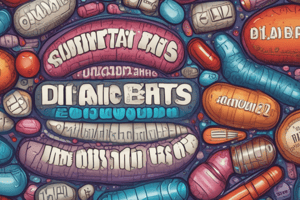Podcast
Questions and Answers
What is the primary function of sulfonylureas in the management of diabetes?
What is the primary function of sulfonylureas in the management of diabetes?
- Stimulate insulin release from pancreatic beta cells (correct)
- Increase glucose production in the liver
- Decrease insulin sensitivity in peripheral tissues
- Inhibit the absorption of glucose in the intestines
Which generation of sulfonylureas is more commonly used due to greater potency?
Which generation of sulfonylureas is more commonly used due to greater potency?
- Both generations are used equally
- First-generation sulfonylureas
- Sulfonylureas are not used in diabetes management
- Second-generation sulfonylureas (correct)
What is a significant risk associated with sulfonylureas when not managed correctly?
What is a significant risk associated with sulfonylureas when not managed correctly?
- Diabetic ketoacidosis
- Hypoglycemia (correct)
- Hyperglycemia
- Weight gain
What mechanism allows sulfonylureas to stimulate insulin release?
What mechanism allows sulfonylureas to stimulate insulin release?
What precaution should clients taking sulfonylureas be educated about?
What precaution should clients taking sulfonylureas be educated about?
Which adverse effect is predominantly associated with first-generation sulfonylureas?
Which adverse effect is predominantly associated with first-generation sulfonylureas?
In terms of therapeutic use, what is the main indication for sulfonylureas?
In terms of therapeutic use, what is the main indication for sulfonylureas?
What does it mean that the insulin release induced by sulfonylureas is 'glucose-dependent'?
What does it mean that the insulin release induced by sulfonylureas is 'glucose-dependent'?
What should be monitored closely in clients with hepatic or renal impairment when taking sulfonylureas?
What should be monitored closely in clients with hepatic or renal impairment when taking sulfonylureas?
Which condition is NOT a contraindication for using sulfonylureas?
Which condition is NOT a contraindication for using sulfonylureas?
What significant risk does sulfonylureas pose to infants of breastfeeding clients?
What significant risk does sulfonylureas pose to infants of breastfeeding clients?
Which of the following statements about drug interactions with sulfonylureas is accurate?
Which of the following statements about drug interactions with sulfonylureas is accurate?
What is a crucial patient teaching point for clients prescribed sulfonylureas?
What is a crucial patient teaching point for clients prescribed sulfonylureas?
Why should sulfonylureas be used cautiously in clients with hepatic issues?
Why should sulfonylureas be used cautiously in clients with hepatic issues?
What is the purpose of monitoring Hemoglobin A1c in clients using sulfonylureas?
What is the purpose of monitoring Hemoglobin A1c in clients using sulfonylureas?
Which of the following best describes the dosing regimen for sulfonylureas?
Which of the following best describes the dosing regimen for sulfonylureas?
What are the potential risks of using sulfonylureas in clients with hepatic or renal impairment?
What are the potential risks of using sulfonylureas in clients with hepatic or renal impairment?
Which of the following statements correctly identifies a contraindication for sulfonylureas?
Which of the following statements correctly identifies a contraindication for sulfonylureas?
What is the impact of beta-blockers on patients taking sulfonylureas?
What is the impact of beta-blockers on patients taking sulfonylureas?
What laboratory test is essential for monitoring the effectiveness of sulfonylureas?
What laboratory test is essential for monitoring the effectiveness of sulfonylureas?
Clients taking sulfonylureas should be educated about recognizing what condition?
Clients taking sulfonylureas should be educated about recognizing what condition?
What dosing method is typically recommended for sulfonylureas?
What dosing method is typically recommended for sulfonylureas?
Why is the use of sulfonylureas contraindicated in breastfeeding clients?
Why is the use of sulfonylureas contraindicated in breastfeeding clients?
What should clients do to manage the risk of hypoglycemia while taking sulfonylureas?
What should clients do to manage the risk of hypoglycemia while taking sulfonylureas?
What is a major reason sulfonylureas are not considered first-line drugs for type 2 diabetes?
What is a major reason sulfonylureas are not considered first-line drugs for type 2 diabetes?
What is the primary therapeutic use of sulfonylureas?
What is the primary therapeutic use of sulfonylureas?
Which mechanism describes how sulfonylureas lead to insulin release?
Which mechanism describes how sulfonylureas lead to insulin release?
Which side effect is particularly associated with the use of first-generation sulfonylureas?
Which side effect is particularly associated with the use of first-generation sulfonylureas?
Why is the insulin release induced by sulfonylureas described as 'glucose-dependent'?
Why is the insulin release induced by sulfonylureas described as 'glucose-dependent'?
What differentiates second-generation sulfonylureas from first-generation sulfonylureas?
What differentiates second-generation sulfonylureas from first-generation sulfonylureas?
Which of the following statements accurately describes the potential risk of hypoglycemia with sulfonylureas?
Which of the following statements accurately describes the potential risk of hypoglycemia with sulfonylureas?
What should patients using sulfonylureas be educated about regarding hypoglycemia?
What should patients using sulfonylureas be educated about regarding hypoglycemia?
What is the primary reason sulfonylureas are contraindicated in pregnancy?
What is the primary reason sulfonylureas are contraindicated in pregnancy?
Which of the following lab tests is NOT typically monitored in patients on sulfonylureas?
Which of the following lab tests is NOT typically monitored in patients on sulfonylureas?
Why should sulfonylureas be used with caution in individuals with hepatic impairment?
Why should sulfonylureas be used with caution in individuals with hepatic impairment?
What effect do non-selective beta-blockers have on patients taking sulfonylureas?
What effect do non-selective beta-blockers have on patients taking sulfonylureas?
What advice should be provided to patients regarding the signs of hypoglycemia while on sulfonylureas?
What advice should be provided to patients regarding the signs of hypoglycemia while on sulfonylureas?
What is a significant risk for infants when a breastfeeding client uses sulfonylureas?
What is a significant risk for infants when a breastfeeding client uses sulfonylureas?
Sulfonylureas should be administered how many times a day?
Sulfonylureas should be administered how many times a day?
In what situation are sulfonylureas typically indicated for use?
In what situation are sulfonylureas typically indicated for use?
What class of drugs do sulfonylureas belong to?
What class of drugs do sulfonylureas belong to?
Which characteristic distinguishes second-generation sulfonylureas from first-generation sulfonylureas?
Which characteristic distinguishes second-generation sulfonylureas from first-generation sulfonylureas?
What is a notable side effect of sulfonylureas that requires client education?
What is a notable side effect of sulfonylureas that requires client education?
What mechanism primarily underlies the action of sulfonylureas?
What mechanism primarily underlies the action of sulfonylureas?
Which of the following are patients taking sulfonylureas cautioned about due to hypoglycemia risk?
Which of the following are patients taking sulfonylureas cautioned about due to hypoglycemia risk?
Which patient population should avoid first-generation sulfonylureas due to a specific risk?
Which patient population should avoid first-generation sulfonylureas due to a specific risk?
What is one of the effects of sulfonylureas being glucose-dependent?
What is one of the effects of sulfonylureas being glucose-dependent?
Why are sulfonylureas not considered first-line treatments for type 2 diabetes?
Why are sulfonylureas not considered first-line treatments for type 2 diabetes?
What unique feature distinguishes second-generation sulfonylureas from first-generation sulfonylureas?
What unique feature distinguishes second-generation sulfonylureas from first-generation sulfonylureas?
Which of the following accurately describes the mechanism of action of sulfonylureas?
Which of the following accurately describes the mechanism of action of sulfonylureas?
What is a significant concern with the use of first-generation sulfonylureas?
What is a significant concern with the use of first-generation sulfonylureas?
What risk is associated with the glucose-dependent nature of insulin release by sulfonylureas?
What risk is associated with the glucose-dependent nature of insulin release by sulfonylureas?
Which class of drugs do sulfonylureas belong to?
Which class of drugs do sulfonylureas belong to?
Why might sulfonylureas not be the first choice in managing type 2 diabetes?
Why might sulfonylureas not be the first choice in managing type 2 diabetes?
What should be monitored closely in patients using sulfonylureas?
What should be monitored closely in patients using sulfonylureas?
Which statement about the side effects of sulfonylureas is correct?
Which statement about the side effects of sulfonylureas is correct?
What is a key reason sulfonylureas are contraindicated in pregnancy?
What is a key reason sulfonylureas are contraindicated in pregnancy?
Why should clients monitor their blood glucose levels regularly when taking sulfonylureas?
Why should clients monitor their blood glucose levels regularly when taking sulfonylureas?
What lab test is essential for assessing the effectiveness of sulfonylureas over time?
What lab test is essential for assessing the effectiveness of sulfonylureas over time?
What effect do non-selective beta-blockers have on clients taking sulfonylureas?
What effect do non-selective beta-blockers have on clients taking sulfonylureas?
Which condition necessitates careful consideration when administering sulfonylureas?
Which condition necessitates careful consideration when administering sulfonylureas?
What is a significant consequence of sulfonylureas for patients who are breastfeeding?
What is a significant consequence of sulfonylureas for patients who are breastfeeding?
What dosing frequency is typically recommended for sulfonylureas?
What dosing frequency is typically recommended for sulfonylureas?
What should be done if a patient taking sulfonylureas shows signs of hypoglycemia?
What should be done if a patient taking sulfonylureas shows signs of hypoglycemia?
Flashcards are hidden until you start studying
Study Notes
Sulfonylureas Overview
- Sulfonylureas are oral hypoglycemic agents used to manage type 2 diabetes.
- Sulfonylureas are not first-line drugs for managing type 2 diabetes due to the risk of hypoglycemia.
- Second-generation sulfonylureas are more commonly used than first-generation drugs due to their increased potency and shorter duration of action.
Mechanism of Action
- Sulfonylureas stimulate insulin release from pancreatic beta cells by:
- Binding to and blocking ATP-sensitive potassium channels in the cell membrane.
- This causes membrane depolarization, calcium influx, and insulin release.
- Insulin release by sulfonylureas is glucose-dependent:
- They are effective in lowering blood glucose levels when glucose is present.
- They pose a risk for hypoglycemia if not managed correctly.
Indications & Therapeutic Uses
- Management of type 2 diabetes to improve glycemic control.
Side Effects & Adverse Reactions
- Hypoglycemia is a common side effect due to increased insulin release. Clients need education on signs, symptoms, and monitoring.
- Cardiovascular toxicity is a concern with first-generation sulfonylureas, but studies are inconclusive.
Precautions & Contraindications
- Use with caution in clients with hepatic or renal impairment as these conditions can affect drug metabolism and excretion.
- Contraindicated in pregnancy due to the risk of neonatal hypoglycemia and potential teratogenic effects.
- Contraindicated in breastfeeding due to the risk of infant hypoglycemia.
Drug Interactions
- Sulfonylureas can interact with other hypoglycemic agents, including:
- Alcohol
- Non-selective beta-blockers
- Insulin
- This can increase the risk of hypoglycemia.
- All beta-blockers can mask hypoglycemia by blocking tachycardia and delaying awareness of decreasing blood sugar.
Dosing, Administration, & Client Teaching
- Dosing varies based on condition, severity, and client response.
- Check drug dosing guidelines for specific dosing information.
- Administration is oral, once or twice daily, depending on the specific drug and client's blood glucose control needs.
- Clients should be educated on:
- The risks of hypoglycemia
- How to monitor for and treat hypoglycemia.
- These medications are only indicated for treatment regimens if medication access or cost is an issue for clients.
Labs to Monitor
- Basic Metabolic Panel (BMP):
- Monitor blood glucose levels and kidney function.
- Hemoglobin A1c:
- Monitor the effectiveness of the treatment regimen.
Sulfonylureas: Overview
- Sulfonylureas are oral hypoglycemic agents used in the management of type 2 diabetes.
- They are not first-line drugs due to the potential for hypoglycemia.
- Second-generation sulfonylureas are more potent with a shorter duration of action than first-generation drugs.
Sulfonylurea Mechanism of Action
- Sulfonylureas stimulate insulin release from pancreatic beta cells.
- They work by blocking ATP-sensitive potassium channels, leading to membrane depolarization, calcium influx, and insulin release.
- Insulin release is glucose-dependent, meaning they effectively lower blood glucose levels when glucose is present, and can pose a risk for hypoglycemia if not managed correctly.
Sulfonylurea Indications & Therapeutic Uses
- They are used to improve glycemic control in clients with type 2 diabetes.
Sulfonylurea Side Effects & Adverse Reactions
- Hypoglycemia: A common side effect due to the stimulation of insulin release. Clients need education on signs, symptoms, and monitoring requirements.
- Cardiovascular Toxicity: A concern with only first-generation sulfonylureas, although research on this is inconclusive.
### Sulfonylurea Precautions & Contraindications
- Precautions: Use with caution in clients with hepatic or renal impairment.
- Contraindications:
- Pregnancy: Risk of neonatal hypoglycemia and potential teratogenic effects.
- Breastfeeding: Risk of infant hypoglycemia.
### Sulfonylurea Drug Interactions
- Other hypoglycemic agents: Increased risk of hypoglycemia.
- Alcohol, non-selective beta-blockers, and insulin: Increase the risk of hypoglycemia.
- Beta-blockers: Can mask hypoglycemia by preventing tachycardia, delaying awareness of low blood sugar.
Sulfonylurea Dosing, Administration, & Client Teaching
- Dosing varies based on condition, severity, and client response.
- Administration is oral, once or twice daily.
- Clients should be educated on the risks of hypoglycemia, monitoring techniques, and how to treat it.
- Sulfonylureas are only indicated for treatment regimens if medication access or cost is an issue for clients.
Sulfonylurea Labs to Monitor
- Basic Metabolic Panel (BMP): Monitors blood glucose levels and kidney function.
- Hemoglobin A1c: Provides information on the effectiveness of the treatment regimen.
Sulfonylureas
- Sulfonylureas are oral hypoglycemic agents used in the management of type 2 diabetes.
- Sulfonylureas stimulate the release of insulin from pancreatic beta cells by blocking ATP-sensitive potassium channels in the cell membrane.
- The release of insulin by sulfonylureas is glucose-dependent, meaning they are effective in lowering blood glucose levels when glucose is present.
- Second-generation sulfonylureas are more commonly used due to their increased potency and shorter duration of action.
Side Effects and Adverse Reactions
- Sulfonylureas can cause hypoglycemia.
- First-generation sulfonylureas can potentially cause cardiovascular toxicity.
Precautions and Contraindications
- Use with caution in clients with hepatic or renal impairment.
- Contraindicated in pregnancy due to the risk of neonatal hypoglycemia and potential teratogenic effects.
- Contraindicated in breastfeeding clients due to the risk of infant hypoglycemia.
Drug Interactions
- Sulfonylureas can interact with other hypoglycemic agents, such as alcohol, non-selective beta-blockers, and insulin, increasing the risk of hypoglycemia.
- All beta-blockers can mask hypoglycemia by blocking tachycardia, delaying awareness of decreasing blood sugar.
Dosing, Administration, & Client Teaching
- Dosing varies based on condition, severity, and client response.
- Administered orally, once or twice daily.
- Clients should regularly monitor their blood glucose levels to avoid hypoglycemia.
- Clients should be educated in recognizing the signs and symptoms of hypoglycemia and how to manage it.
Labs to Monitor
- A basic metabolic panel (BMP) can be used to monitor blood glucose levels and kidney function.
- Monitoring hemoglobin A1c will provide information on the effectiveness of the treatment regimen.
Sulfonylureas
- Oral hypoglycemic agents used to manage type 2 diabetes.
- Not first-line drugs for managing type 2 diabetes because they can cause hypoglycemia.
- Second-generation sulfonylureas are more commonly used due to their increased potency and shorter duration of action.
Mechanism of Action
- Stimulate the release of insulin from pancreatic beta cells.
- Bind and block ATP-sensitive potassium channels in the cell membrane.
- This causes membrane depolarization, calcium influx, and insulin release.
- Insulin release is glucose-dependent, meaning they are effective in lowering blood glucose levels when glucose is present.
- Can pose a risk for hypoglycemia if not managed correctly.
Indications and Therapeutic Uses
- Used to improve glycemic control in clients with type 2 diabetes.
Side Effects and Adverse Reactions
- Hypoglycemia: Can cause this side effect because they actively drive down blood sugar by stimulating insulin release. Clients should be educated about signs, symptoms, and monitoring requirements.
- Cardiovascular Toxicity: Concern with first-generation sulfonylureas only. Studies have been inconclusive.
Precautions
- Use with caution in clients with hepatic or renal impairment.
- These conditions can affect drug metabolism and excretion, increasing the risk of adverse effects.
Contraindications
- Pregnancy: Contraindicated due to the risk of neonatal hypoglycemia and potential teratogenic effects observed in animal studies.
- Breastfeeding: Contraindicated due to the risk of infant hypoglycemia.
Drug Interactions
- Can interact with other hypoglycemic agents, including alcohol, non-selective beta-blockers, and insulin.
- Increased risk of hypoglycemia.
- All beta-blockers can mask hypoglycemia by blocking tachycardia, delaying awareness of decreasing blood sugar.
Dosing, Administration, & Client Teaching
- Dosing varies based on condition, severity, and client response.
- Check drug dosing guidelines for individualized dosing.
- Dosed orally, once or twice daily, depending on the specific drug and client's blood glucose control needs.
- Ensure clients know the risks of hypoglycemia and how to monitor for and treat it.
- These medications are only indicated for treatment regimens if medication access or cost is an issue for clients.
Administration
- PO administration.
Client Teaching
- Clients should regularly monitor their blood glucose levels to avoid hypoglycemia.
- Clients should be educated on recognizing the signs and symptoms of hypoglycemia and how to manage it should it occur.
- Advise clients who are pregnant or attempting to become pregnant to discuss with their provider as sulfonylureas are not safe in pregnancy or breastfeeding.
Labs to Monitor
- Basic Metabolic Panel (BMP): Can be used to monitor blood glucose levels and kidney function.
- Hemoglobin A1c: Monitoring will provide information on the effectiveness of the treatment regimen.
Studying That Suits You
Use AI to generate personalized quizzes and flashcards to suit your learning preferences.




